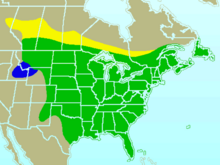Blue jay
| Blue jay | |
|---|---|
 |
|
| In Algonquin Provincial Park, Canada | |
| Scientific classification | |
| Kingdom: | Animalia |
| Phylum: | Chordata |
| Class: | Aves |
| Order: | Passeriformes |
| Family: | Corvidae |
| Genus: | Cyanocitta |
| Species: | C. cristata |
| Binomial name | |
|
Cyanocitta cristata (Linnaeus, 1758) |
|
| Subspecies | |
|
4 sspp., see text |
|
 |
|
| Global range Breeding range Year-round range Wintering rangeSee also text for recent range expansion. |
|
4 sspp., see text
The blue jay (Cyanocitta cristata) is a passerine bird in the family Corvidae, native to North America. It is resident through most of eastern and central United States, although western populations may be migratory. Resident populations are also found in Newfoundland, Canada, while breeding populations can be found in southern Canada. It breeds in both deciduous and coniferous forests, and is common near and in residential areas. It is predominantly blue with a white chest and underparts, and a blue crest. It has a black, U-shaped collar around its neck and a black border behind the crest. Sexes are similar in size and plumage, and plumage does not vary throughout the year. Four subspecies of the blue jay are recognized.
The blue jay mainly feeds on nuts and seeds such as acorns, soft fruits, arthropods, and occasionally small vertebrates. It typically gleans food from trees, shrubs, and the ground, though it sometimes hawks insects from the air. Like squirrels, blue jays are known to hide nuts for later consumption. It builds an open cup nest in the branches of a tree, which both sexes participate in constructing. The clutch can contain two to seven eggs, which are blueish or light brown with brown spots. Young are altricial, and are brooded by the female for 8–12 days after hatching. They may remain with their parents for one to two months.
The bird's name derives from its noisy, garrulous nature. It is sometimes called a "jaybird".
The blue jay was first described as Pica glandaria cærulea cristata in English naturalist Mark Catesby's 1731 publication of Natural History of Carolina, Florida, and the Bahamas. It was later described as Corvus cristatus in Carl Linnaeus' 1758 edition of Systema Naturae. In the 19th century, the jay was described by French ornithologist Charles Lucien Bonaparte in 1838 as Cyanocorax cristatus in A geographical and comparative list of the birds of Europe and North America, and given its modern scientific name Cyanocitta cristata by Hugh Edwin Strickland in 1845.
...
Wikipedia

